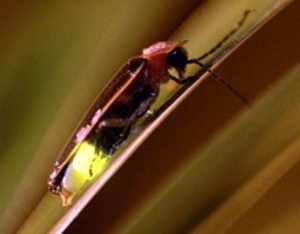Southern Minnesota had an especially late and moist spring in 2008, and the lightning bugs were out in droves every evening. As kids, we grew up watching, chasing and catching lightning bugs, but never before have I seen so many. This prompted me to investigate a bit further and learn more about the lightning bug, also often called a firefly.
Lightning bugs are a member of the beetle family, despite being called fireflies and, in some areas, glowworms; they are neither flies nor worms. What makes the lightning bug remarkable is its bioluminescence. In other words, a primary characteristic of the lightning bug is its ability to glow or display a pulsating light from the underside of its body.
Lightning bugs are found primarily in humid climates, where there is vegetation and moisture: near streams, marshes, ditches, water ways, ponds, etc. There are some exceptions, but since I live in a humid area with lots of woods and nearby water, ours is a perfect location for these flashing bugs.
The female lightning bug lays her eggs in the ground. The larvae develop underground and feed on snails, slugs, worms and organic material. According to the National Geographic (NG) website, however, when lightning bugs become adults, some don’t eat at all. Those that do are omnivores and generally feed on pollen or nectar. It makes sense, then, that their lifespan is typically just a couple of months.
But back to their bioluminescence. All the larvae are luminescent, although it’s generally just the adult insects that we notice flashing their pale yellow/green light. Even then, not all adults are luminescent.
There are several theories as to why lightning bugs flash. The fact that all lightning bug larvae flash supports a theory that it may be a defense mechanism. The pulsating light warns potential predators that the larvae tastes bad and is not good to eat. Information on the NG website suggests another theory: the phenomenon of aggressive mimicry where one bug mimics the luminescence of another bug, tricking a third unsuspecting bug into coming close. The duped bug then becomes a meal for the mimicking lightning bug. However, NG also states adult lightning bugs have virtually never been observed eating other prey, so this theory may not be completely accurate. A third theory is the most popular: the lightening bug’s flashing lights have something to do with mating.
In an online article entitled “The Firefly Files,” Marc Branham supports the mating theory. His article explains that male and female lightning bugs communicate their attraction through a flash pattern, and the courtship begins.
In my limited research, I was unable to find an answer for why lightning bugs exist. What is their role in the ecosystem? My personal theory is that they are simply nature’s fireworks. They are the most enjoyable insect species to watch. For several evenings, we sat on our deck and watched literally thousands of these wonderful creatures fly and flash and dazzle us with their beauty. The younger kids would see a nearby flash and attempt to anticipate the location of the lightning bug and its next flash. With several lightning bugs eventually captured and placed in a jar, the pulsating light in a kid’s dark bedroom is something to behold. The bugs would be released the next morning, and the chase and catch would be on again that night.
However they work and whatever their purpose, lightning bugs provided hours of entertainment and speculation this especially moist spring in southern Minnesota.
Resources:
National Geographic; http://animals.nationalgeographic.com/animals/bugs/firefly.html
Article, “The Firefly Files” by Marc Branham; http://iris.biosci.ohio-state.edu/projects/FFiles/frfact.html







